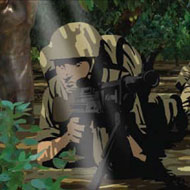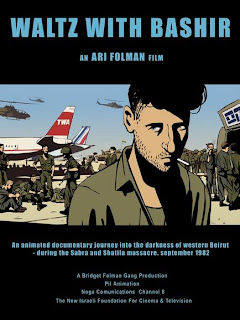



This gives the picture a feel that is both evocative and down-to-earth, a bizarre but powerful combination that has earned Waltz With Bashir comparisons with the similarly merciless Apocalypse Now. After all, how do you show a live-action dream sequence in a documentary without making it look corny? Hence the winning choice of rendering the whole story through animation, with just one exception (the final scene, the one that justifies the film's existence, consists of real filmed material). The stream of personal anecdotes and, as said earlier, dreams, made it impossible for Folman to show real footage of what he was trying to say. Engaging in a pursuit of the truth, the director locates several people with first-hand recollections of those events, and all these people (minus two) supply their own voices for their animated counterparts. All they have left is dreams, like the haunting nightmare that opens the movie (26 murderous dogs surrounding the apartment of a former soldier, who believes it to be a subconscious punishment for his killing 26 dogs during a mission) or Folman's eerie flashback of himself and his friends emerging from the water after a massacre he can't (or perhaps doesn't want to) remember. Folman's introspective journey begins with the lack of memory: apparently, he and many of his fellow soldiers have trouble remembering the exact details of what happened in Lebanon. In doing so, he delivered one of the strongest, boldest documents about the true nature of conflict.

However, he still wasn't able to completely get over the war experience, and so he decided to make Waltz With Bashir in order to exorcise his demons, so to speak. Once the war was over, Folman's new career began, and he is now a successful actor, director and writer (among other things, he worked on the TV show that inspired HBO's In Treatment). Folman, like many young Israeli men in the '80s, joined the army to fight in Lebanon when he was merely 18 (this was in 1982), thinking he could serve his country in the best way possible. In the case of Ari Folman, the choice was dictated by the unique angle from which he chose to tell the story: subjectivity. They do have one important thing in common, though: they are animated not because it looked good, but because it was the best artistic choice the directors could make. The comparison was also caused by both movies having open anti-war messages, but they couldn't be more different in concept and execution. It may sound like a paradox, but hey, when the film played at the Cannes Film Festival (which it left with rave reviews but zero awards) it was inevitably compared to Persepolis, which is an animated autobiography. Let's get one thing straight from the beginning: Waltz With Bashir is an animated documentary.


 0 kommentar(er)
0 kommentar(er)
